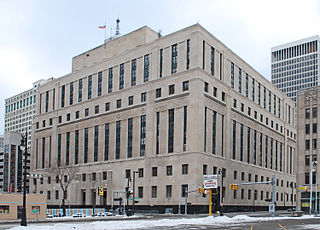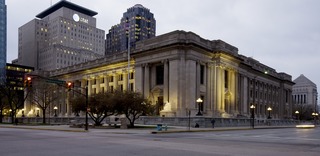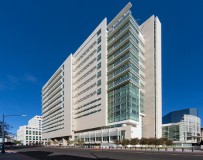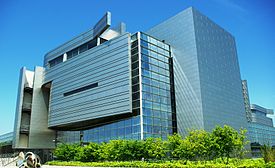
Thom Mayne is an American architect. He is based in Los Angeles. In 1972, Mayne helped found the Southern California Institute of Architecture (SCI-Arc), where he is a trustee and the coordinator of the Design of Cities postgraduate program. Since then he has held teaching positions at SCI-Arc, the California State Polytechnic University, Pomona and the University of California, Los Angeles (UCLA). He is principal of Morphosis Architects, an architectural firm based in Culver City, California and New York City, New York. Mayne received the Pritzker Architecture Prize in March 2005.

The John Joseph Moakley United States Courthouse is a federal courthouse for the United States Court of Appeals for the First Circuit and the United States District Court for the District of Massachusetts, located on Fan Pier on the Boston, Massachusetts waterfront. Named after Congressman Joe Moakley, the 675,000-square-foot (62,700 m2) building was completed in 1999 at a cost of $170 million and has won many design awards.

The Mark O. Hatfield United States Courthouse is a federal courthouse in Portland, Oregon. It is named in honor of former U.S. Senator Mark O. Hatfield. It is used by the United States District Court for the District of Oregon.

The Theodore Levin United States Courthouse is a large high-rise courthouse and office building located at 231 West Lafayette Boulevard in downtown Detroit, Michigan. The structure occupies an entire block, girdled by Shelby Street (east), Washington Boulevard (west), West Fort Street (south), and West Lafayette Boulevard (north). The building is named after the late Theodore Levin, a lawyer and United States District Court judge.

The James A. Walsh United States Courthouse, also or formerly named U.S. Post Office and Courthouse, is a historic post office and courthouse building located at Tucson at Pima County, Arizona. It was a courthouse of the United States District Court for the District of Arizona.

The James R. Browning U.S. Court of Appeals Building is a historic post office and courthouse building located at San Francisco, California. It is a courthouse for the United States Court of Appeals for the Ninth Circuit. Completed in 1905 as the U.S. Courthouse and Post Office, it was intended to represent the affluence and increasing importance of the United States as it became a world power. The building survived both the 1906 San Francisco earthquake and the 1989 Loma Prieta earthquake.

The Everett McKinley Dirksen United States Courthouse, commonly referred to as the Dirksen Federal Building, is a skyscraper in the Chicago Loop at 219 South Dearborn Street. It was designed by Ludwig Mies van der Rohe and completed in 1964. The building is 384 feet (117 m) tall with 30 floors; it was named for U.S. Congressman Everett Dirksen. The building houses the United States Court of Appeals for the Seventh Circuit, the United States District Court for the Northern District of Illinois, the United States Bankruptcy Court, the United States Marshal for the Northern District of Illinois, United States Attorney for the Northern District of Illinois, and local offices for various court-related federal agencies, such as the Federal Public Defender, United States Probation Service, United States Trustee, and National Labor Relations Board. It is one of three buildings making up the modernist Chicago Federal Center complex designed by van der Rohe, along with Federal Plaza, the U.S. Post Office and the Kluczynski Federal Building. Separate from the Federal Plaza, but opposite the Kluczynski Building across Jackson Boulevard, is the Metcalfe Federal Building.

The Birch Bayh Federal Building and U.S. Courthouse, formerly known as the U.S. Courthouse and Post Office and as the Federal Building, is a courthouse of the United States District Court for the Southern District of Indiana, located in Indianapolis. It is a distinguished example of Beaux-Arts architecture, and was listed in the National Register of Historic Places in 1974. Constructed from 1902 to 1905, the United States District Court for the District of Indiana met here until it was subdivided in 1928; the United States Circuit Court for the District of Indiana met here until that court was abolished in 1912. It was listed on the National Register of Historic Places as "U.S. Courthouse and Post Office" in 1974. The courthouse was renamed in honor of Senator Birch Bayh in 2003.

The United States Courthouse, also known as the Federal Building, is a historic building located in Davenport, Iowa, United States. It has historically housed a post office, courthouse, and other offices of the United States government. The building now serves only as a federal courthouse, housing operations of the eastern division of the United States District Court for the Southern District of Iowa. In 2018, the operations of the Rock Island division of the United States District Court for the Central District of Illinois were also moved there.

The William J. Holloway Jr. United States Courthouse in Oklahoma City, Oklahoma is a courthouse of the United States District Court for the Western District of Oklahoma and the United States Court of Appeals for the Tenth Circuit.

The Federal Building and Post Office is a historic main post office, courthouse, and Federal office building at 271-301 Cadman Plaza East in the Downtown Brooklyn neighborhood of Brooklyn in New York City. The original building was the Brooklyn General Post Office, and is now the Downtown Brooklyn Station, and the north addition is the courthouse for the United States Bankruptcy Court for the Eastern District of New York, and is across the street from and in the jurisdiction of the main courthouse of the United States District Court for the Eastern District of New York, the Theodore Roosevelt United States Courthouse. It also houses offices for the United States Attorney, In 2009, the United States Congress renamed the building the Conrad B. Duberstein United States Bankruptcy Courthouse, after chief bankruptcy judge Conrad B. Duberstein.

The James T. Foley United States Courthouse is a stone Art Deco federal courthouse, located on Broadway in downtown Albany, New York, United States. Built in the 1930s, it was included in 1980 as a contributing property when the Downtown Albany Historic District was listed on the National Register of Historic Places. In 2020 it was listed on the Register individually as the United States Post Office, Court House, and Custom House.

The Gus J. Solomon United States Courthouse is a federal courthouse located in downtown Portland, Oregon, United States. Completed in 1933, it previously housed the United States District Court for the District of Oregon until the Mark O. Hatfield United States Courthouse opened in 1997. The Renaissance Revival courthouse currently is used by commercial tenants and formerly housed a U.S. Postal Service branch. In 1979, the building was added to the National Register of Historic Places as U.S. Courthouse.

The William J. Nealon Federal Building and United States Courthouse is a courthouse of the United States District Court for the Middle District of Pennsylvania, located in Scranton, Pennsylvania. It was completed in 1931, and was listed on the National Register of Historic Places in 2018.

The James A. Redden Federal Courthouse, formerly the United States Post Office and Courthouse, is a federal courthouse located in Medford, Jackson County, Oregon, United States. Completed in 1916 under the supervision of architect Oscar Wenderoth, it houses the United States District Court for the District of Oregon. A substantial extension was completed in 1940, under the supervision of architect, Louis A. Simon. In September 1996, the United States Senate enacted a bill introduced by Oregon Senator Mark Hatfield to rename the building for long-serving District Court judge James A. Redden.

The William Kenzo Nakamura United States Courthouse is a federal courthouse in Seattle, Washington primarily used by the United States Court of Appeals for the Ninth Circuit. Built in 1940 as the United States Courthouse to consolidate federal agencies within the city, it was renamed for Medal of Honor recipient William K. Nakamura in 2001. The Ninth Circuit started using the building in the 1970s and became the principal tenant in 2004 when most other users moved to the new 23-story United States Courthouse in the Denny Triangle.

The John Archibald Campbell United States Courthouse, also known as the United States Court House and Custom House, is a historic courthouse and former custom house in Mobile, Alabama. It was completed in 1935. An addition to the west was completed in 1940. It was added to the National Register of Historic Places on October 8, 2008.

The Orrin G. Hatch United States Courthouse in Salt Lake City, Utah, United States is a federal courthouse located at 351 South West Temple Street in downtown Salt Lake City, on the corner of 400 South and West Temple. It is located behind the Frank E. Moss United States Courthouse. The building houses the United States District Court for the District of Utah. It opened in April 2014.

The James M. Carter and Judith N. Keep United States Courthouse, also known simply as the Carter-Keep Courthouse, at 333 West Broadway in San Diego, California, is a sixteen-story federal courthouse facility on 2.6 acres (11,000 m2) that includes courtrooms, judges chambers, offices and courtroom galleries of the United States District Court for the Southern District of California, along with offices of the Internal Revenue Service and the General Services Administration.

The Austin United States Courthouse is a federal courthouse in downtown Austin, Texas. Built between 2009 and 2012, the building houses the Austin division of the United States District Court for the Western District of Texas and other federal judicial offices. It replaced the 1936 Austin U.S. Courthouse, which has since been transferred to Travis County to hold county judicial space.























